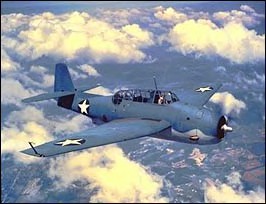The Avenger was Grumman's first torpedo aircraft, and its design had much in common with that of the Company's fighters - as its chunky and robust appearance testifies. The design and engineering team under W.T. Schwendler developed the aircraft very quickly - the order for two prototypes was placed on 8 April 1940 and the first Avengers went into service just over two years later.
The new plane first saw action on 4 June 1942 against the Japanese carrier striking force at the Battle of Midway - only six Avengers were involved, operating from Midway Island. They were forced to attack against overwhelming odds, and five of the six were shot down, the surviving plane returning to Midway severely damaged and with its gunner dead. However, the survival of this aircraft demonstrated the TBF's great toughness, and it was immediately apparent that its battle-worthiness justified its production in great numbers.
The Avenger rapidly displaced the obsolete Devastator aboard US carriers, and from the Guadalcanal landings in August 1942 until the end of the PacificWar it remained the only shipboard torpedo aircraft of the US Navy.
The US Navy's demands for Grumman production of the F6F Hellcat fighter led to manufacture of the Avenger being taken over by Eastern Aircraft Division of General Motors - the GM-produced aircraft being designated the "TBM".
The Avenger took part in every carrier-versus-carrier battle and indeed almost all carrier operations from Midway onwards, working from every fast carrier and escort carrier of the Pacific Fleet. At Guadalcanal and in subsequent campaigns it was also active from land bases. For almost all of this time it operated as a bomber, and as a search and anti-submarine aircraft, rather than as a torpedo-plane. As a torpedo-plane it was initially hampered by the many serious defects in the American torpedoes. Moreover the crushing losses inflicted on their torpedo squadrons at the Battle of Midway left the United States Navy with little confidence in aerial torpedo attack, confidence which was only regained with the success of the Avengers at the Battle of the Philippine Sea.
Nonetheless, in the Naval Battle of Guadalcanal, November 1942, TBFs inflicted heavy damage on the Japanese battleship Hiei with torpedoes after she had been crippled by US surface forces. At Philippine Sea in June 1944, equipped with greatly improved torpedoes, Avengers hit the carrier Hiyo, which sank soon afterwards. In this respect they were more successful than the American dive-bombers at Philippine Sea, and this increased US Navy's emphasis on torpedo attack in subsequent operations.
In the Battle for Leyte Gulf the TBF / TBM achieved one of its most notable successes by sinking (with 19 torpedo hits) the Japanese battleship Musashi, which at 67,000 tons was one of the two largest warships in the world (the other being her sister ship Yamato). Later in the battle Avengers played an heroic and vital role in the desperate defence of the US escort carrier group "Taffy 3" which unexpectedly came under surface attack from the main Japanese force off Samar.
On 7 April 1945, during the Okinawa operation, Avengers of Task Force 58 played the main part in sinking the Yamato, formerly Admiral Yamamoto's flagship - hitting the huge battleship with ten or more torpedoes.
The Avenger's virtues, especially its ruggedness, reliability, and stability as a weapons platform, ensured it a remarkably long operational history. It in fact remained in service - as an anti-submarine and airborne early-warning aircraft - until 1954.
 Manufacturer: Grumman
Manufacturer: Grumman
Powerplant: Wright R-2600 Double Cyclone 14 cylinder radial 1,700 hp
Wing span: 54 feet, 2 inches
Length: 40 feet, 9 inches
Height: 13 feet, 9 inches
Max takeoff: 16412 lbs
Crew: 3
Weight empty: 10100 lbs, 4580 kg
Weignt loaded: 13700 lbs, 6215 kg
Armament: one 12.7mm (.50 cal) gun, one 7.7mm (.30 cal) gun operated by the radioman.
Ordinance: Two 455 kg (1,000 lb) bombs, or one torpedo.
Max speed: 270 mph, 440 kph
Range: 1130 miles
Ceiling: 23400 feet
